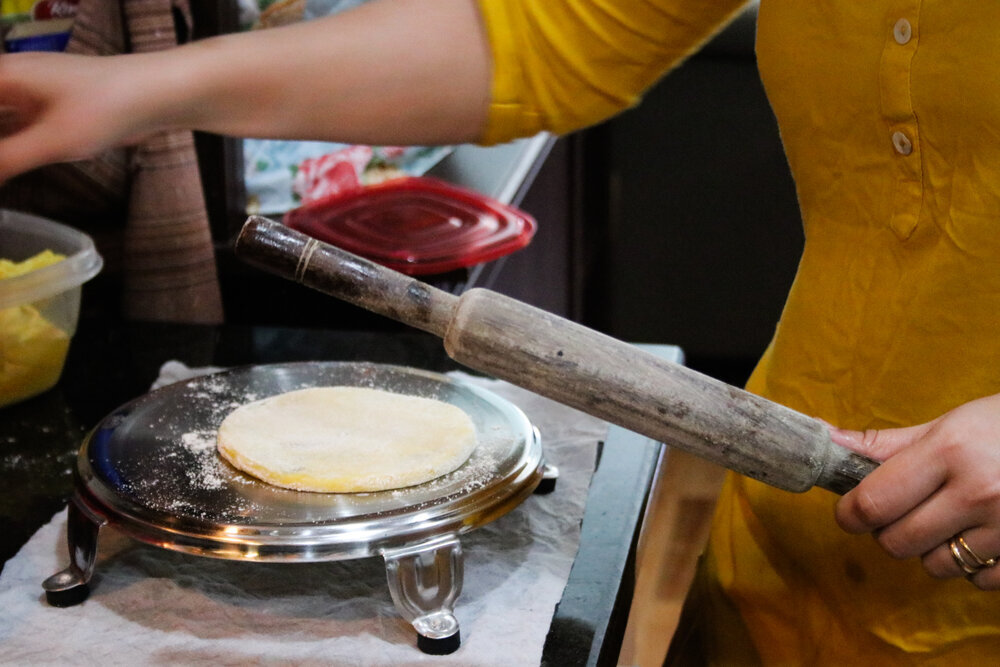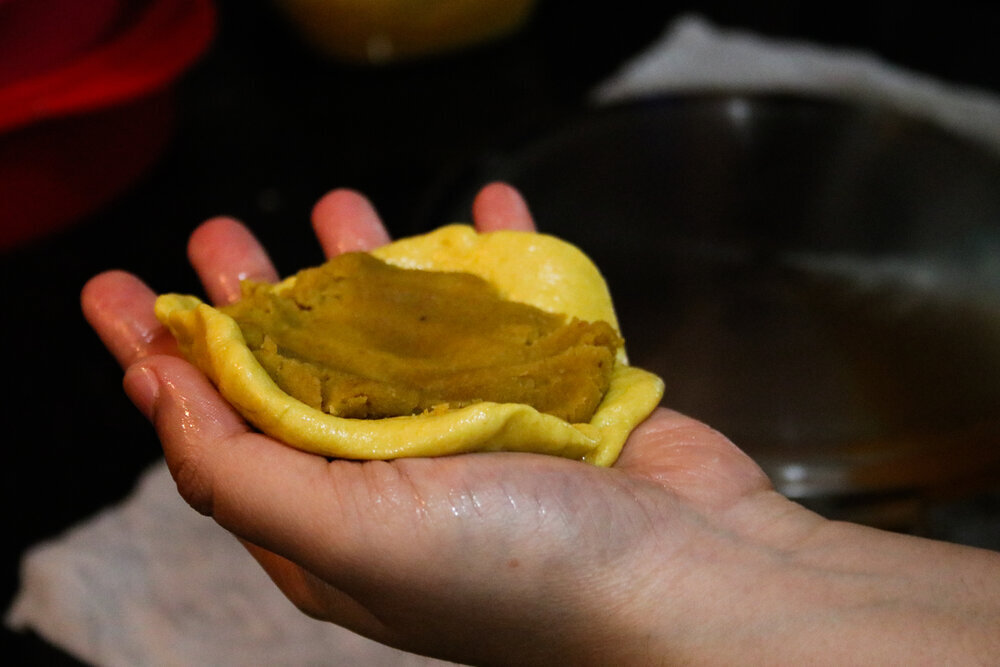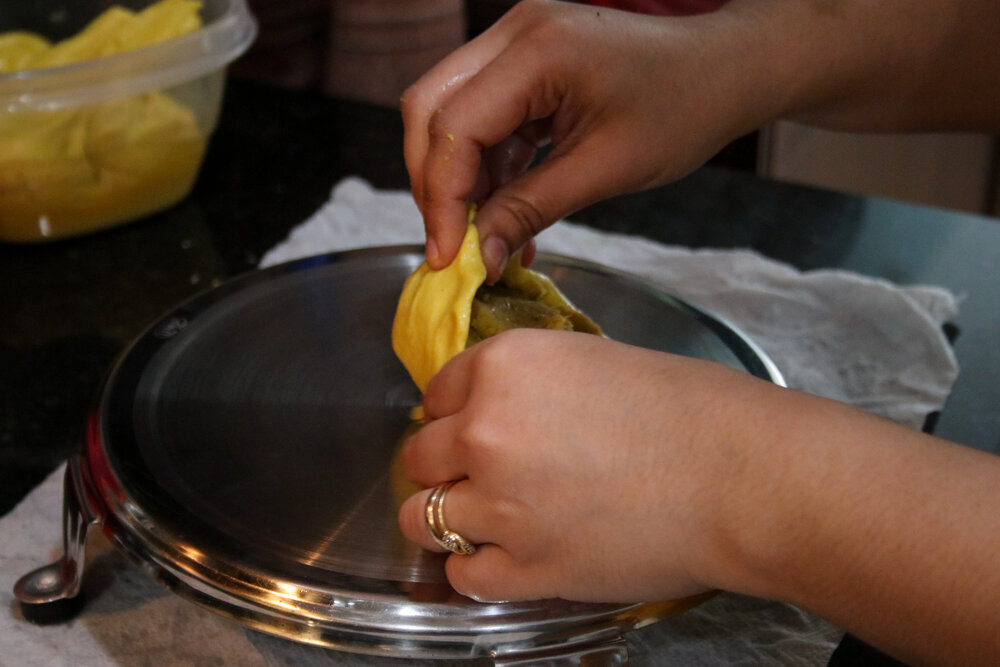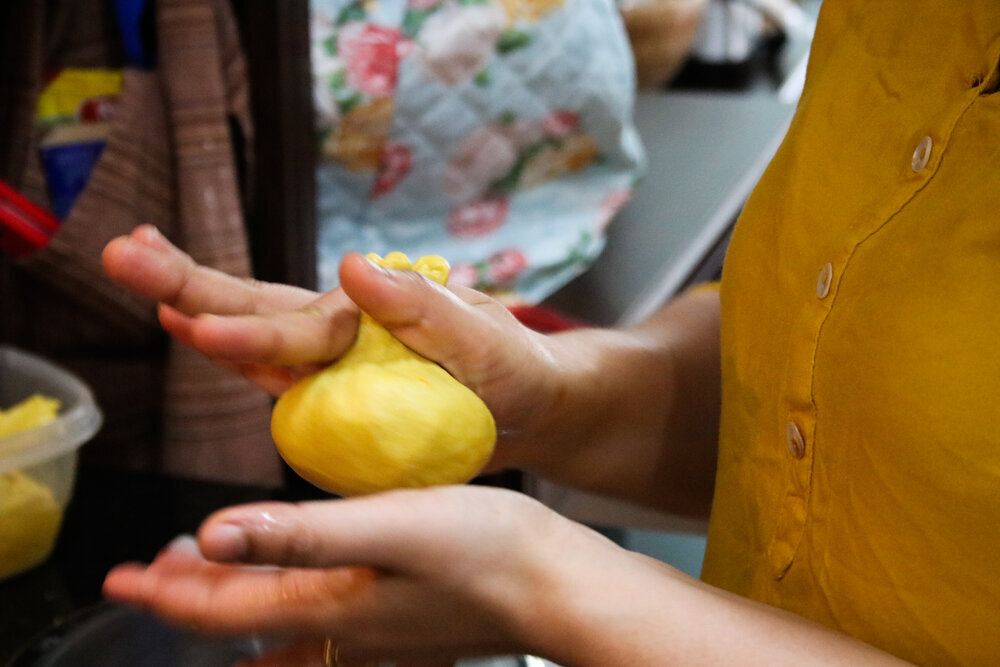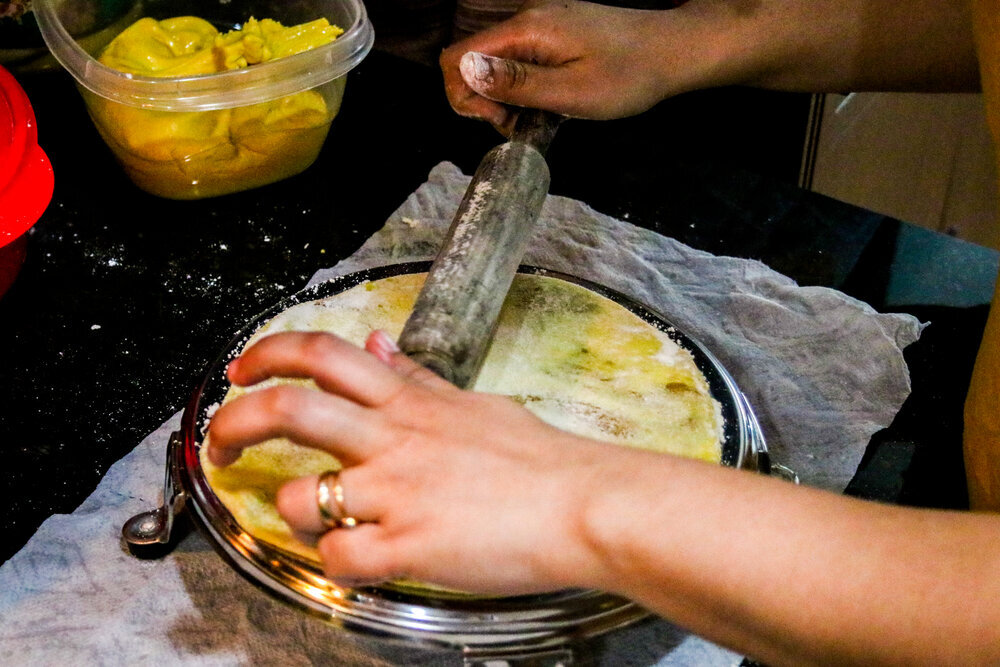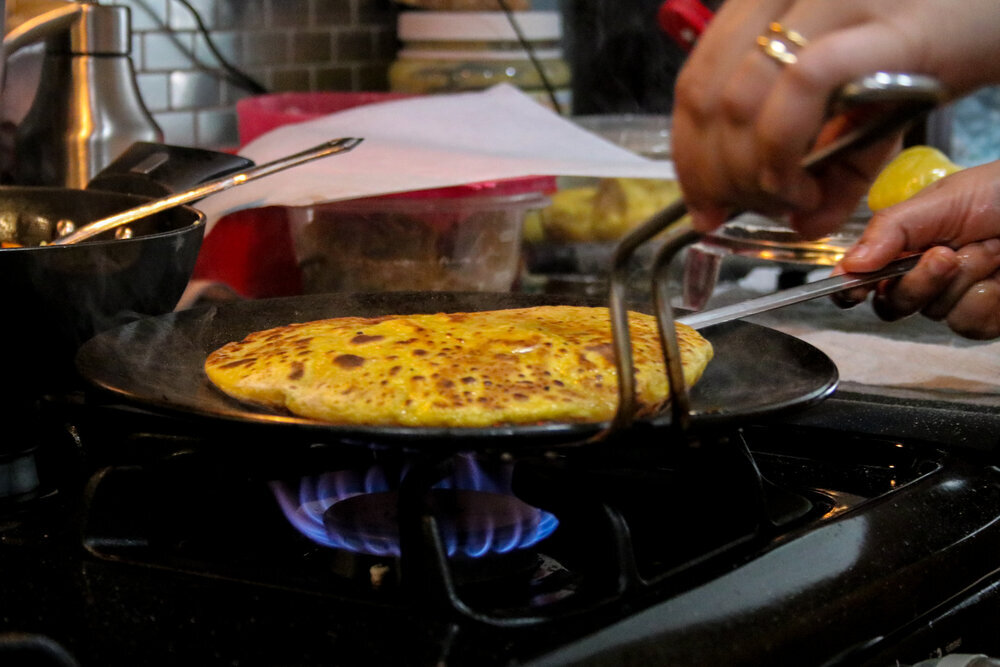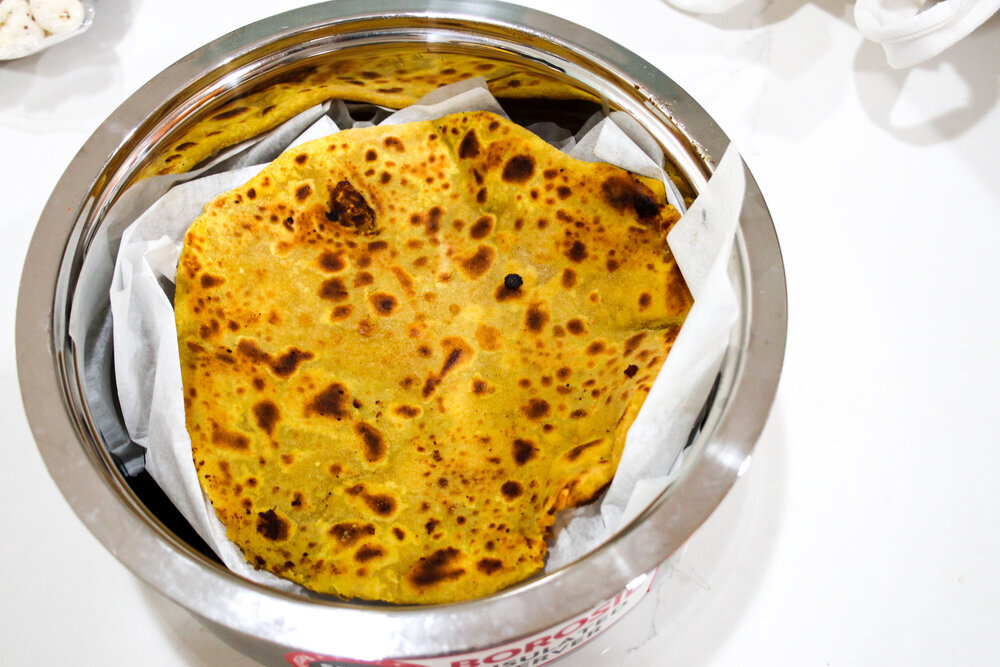India: Madura
Puran Poli + Katachi Amti
[skip to the recipe]
This visit occurred before the quarantine in early March — and offered up such a wonderful last hurrah for The American Feast Collective. Madura breathed new life into my love for this project. My itch to get back into the kitchen and write has only grown over the last few months of being solitary, but watching others create in their own kitchens has been therapeutic as well. I connected with Madura over a Facebook group for women in the culinary industry. We chatted on the phone and I told her about my project. Madura briefly explained her Maharashtrian roots. Without too many words, and a whole lot of trust, Madura agreed to let me spend a day with her cooking in her apartment in Philadelphia.
When the morning comes, I drive through the streets of Philly, admiring the scenery leading up to the Art District where Madura lives. I pull onto a narrow road, quiet and tucked away from the bustling city I’d taken on the night before.
I nervously ring the bell. When the door opens, I’m greeted by a woman my height with a glowing cinnamon complexion. Her dark curls fall just above her shoulder. Madura is wearing a bright yellow shirt and an even brighter smile. I am instantly put at ease by her energy and warmth. She guides me up a long narrow staircase to her apartment door.
We enter into a narrow, dimly lit hallway, and the morning light pours in from windows at the other end, a beacon to mark the heart of her apartment. A compact island separates the kitchen from the living area, leaving just enough space for the two of us to walk between the island and the stove. I ask Madura to remind me of many of the details we discussed during our initial phone conversation, the first detail being where she is from.
We find Maharashtra on a map together — a large, coastal, and mid-west region of India, the second most populous state in the country. Madura is from Konkan, a belt of land spanning three hundred thirty miles down the western coastline. Mumbai, the most populous city in India, is nestled at the northern end. Today, Madura will cook me a small feast representative of Maharashtrian cuisine with a focus on Puran Poli, a flatbread made specifically for Holi, the Hindu festival of spring.
Though I’ve probably eaten more Indian food in my life than the average person (living in London will have you crawling back for more), I’m completely unfamiliar with geography in India and the specifics of their regional cuisines. India is one third the size of the US, and to assume it has one culture and one cuisine is doing yourself a disservice. You’d be missing out on the beauty of their varying topography and rich history telling you its stories through food.
We settle in between the stove and the island, and share a moment recognizing the American palate is unfamiliar with most types of Indian food. She cautions me with her dish, explaining it won’t be the typical Indian food I’ve found in restaurants. We joke about the assumption that Tikka Masala is the only dish that exists within Indian cuisine in the US.
The dishes we’ll be making today will give us a small taste of what we might eat during Holi in Maharashtra. A mixture of lentils, rice, and a huge variety of spices, the dishes are interesting because they contain shared components — you wouldn’t necessarily make one without the other. (If you don’t quite understand what I mean, you will soon!)
We’re going to make Puran Poli, a sweet stuffed flatbread, served alongside rice, dal, potato subzi, and a spicy soup called Katachi Amti. (For the purposes of this article, I’ll be focusing on Puran Poli and Katachi Amti.)
On the counter, Madura places three large containers filled with golden yellow dal. She points to each one and explains what you might use them for. Recently, I excitedly profess I’ve been making a lot of Khichadi, a rice and lentil porridge-like dish lightly spiced and often served with ghee. It’s delicious, soothing, and easy on your digestive track. Madura explains that Khichadi is made differently all over India, changing between regions depending on the dals and grains available. For her, Khichadi is a mixture of rice and toor dal, but in other areas of Maharashtra it might become a mixture of toor and mung dal. She jokes she could open up a whole restaurant called Khichadi and serve the different varieties.
But Madura is already in the food business. She recently launched Chai Bar, a farmer’s market pop-up, inspired by her love of her culture and home, and of course, sharing authentic Chai with her America. Her varying chai blends are reminiscent of her life in Maharashtra, where she’d often share a cup of chai with a neighbor, family member, or friend.
“Would you like to have some chai?” Madura asks. My eyes light up. “Great. Do you like ginger?” My mouth is watering already.
Before Madura shows me how to make the perfect cup of chai, she measures out a small amount of chana dal, one of the larger lentils I met earlier. I watch as the dal is rinsed and the silt pours down the drain. We soak the chana dal briefly, then pour it into a pressure cooker with fresh water.
I ask how much water she uses for the dal. We hadn’t measured anything out. She usually just eyeballs it, but to show me, she presses a finger gently through the water onto the lentils and points to the crease in her finger. This is where the water should be. I’ve heard this trick from a few people, it seems to know no cultural bounds.
Then, she opens a round, red tupperware. Inside, there are several little bowls of spices with tiny spoons in each. She sprinkles half a teaspoon of turmeric onto the lentils and adds a bit of olive oil. Sealing the lid and turning the heat up to medium, we forget about the dal for a little while and return our focus to the chai.
“I really like ginger chai. I’m the queen of ginger you could say!” Madura laughs.
We pull out a pot Madura uses specifically for chai. She swiftly grates ginger into the pot and my nose is greeted by the potent, invigorating scent. I watch as she grates about three inches of ginger, but she explains chai is entirely up to the preference of the drinker. Madura’s suggestion is about one inch of ginger per cup.
Next, she takes out a large Ziploc of lemongrass that she grew and dried last summer. Lemongrass is a pretty low-maintenance plant so it’s easy to grow. We follow it with a bit of coarsely ground cardamom.
“I always encourage people to find their own flavors that they like, mix and match. Chai is all about whatever you want to do with it! Some people like five spices, but some may like ten! So there’s no hard and fast rule.”
We’re going to let the ginger, lemongrass, and cardamom mixture boil in water. “Chai has some basics: a lot of boiling and a lot of patience,” Madura explains.
The ginger/lemongrass mixture begins to come to a rolling boil. We watch it for a minute or so, and then add tea leaves. (Madura uses high quality black tea, but I made it again at home with organic black tea bags and it worked just as well. Though it did give me a huge kick of caffeine and a decent amount of afternoon anxiety.) Once the tea leaves are in and the water begins to foam on top, it quickly returns to a rolling boil.
The pressure cooker begins to steam in the background, reminding us of the chana dal we have cooking on the stove. Madura pours a splash of milk and a few teaspoons of raw sugar into the boiling chai. The waves of the water settle down as the milk cools them.
“I feel like people don’t really know chai,” Madura continues. “—They don’t really know the culture that comes along with it. People always say, ‘Oh my god! I love chai!’ and I am saddened because Starbucks chai is not chai.” But she’s found a way to ignite her community’s passion for chai through Chai Bar. Friends and strangers alike look forward to seeing her at the farmer’s market.
Once it returns to another rolling boil, Madura lowers the flame, and lets it simmer again for about a minute as the milk and sugar meld with the intensity of the black tea. It turns a deep rich caramel and Madura turns off the flame to let the chai settle.
The last steam comes along and we turn off the flame beneath the chana dal to let the pressure begin to release. As the chai steeps, Madura tells me about Alphonso mangoes. The king of mangoes, she calls them. Hailing from India, the Alphonso mango is a sweet mango, smaller and less fibrous than the softball-sized fruit we’re accustomed to eating.
Indian grocery stores sell out of Alphonso mangoes in late spring, sometimes before they’ve even arrived. Madura assures me it’s worth getting on the waiting list for them. I ask if these are the mangoes you’d use for pickling. “Ah, yes! The best pickles in India are made out of Alphonso mangoes.” Different pickles will let you know what mango they’ve used. She heads over to her refrigerator and pulls down a huge box of jarred pickles. I look closer at a jar labeled vadu mangoes. Vadu mango pickle is made from olive-sized baby mangoes. I’m confused for a moment, as most mangoes I’ve eaten require me to use a knife to peel the flesh back from a gigantic pit.
“What about the pit?” I ask. Madura explains the mangoes are so young that the pit hasn’t hardened yet, making the entire pickle soft and edible. I’m looking forward to trying it with our meal later on.
Almost ten minutes have passed, and Madura strains the chai into two mugs. It’s become the color of a perfectly brewed latte. I press my hands around the steaming mug of spicy chai, eager to take a sip but hesitant to burn my mouth.
Madura has been in the US for six years now. She misses Alphonso mango season. Growing up in Konkan, they had a separate fruit room where they’d dump five hundred mangoes harvested from her yard. “Five hundred mangoes?!” I exclaim. “Wouldn’t you worry about them going bad?” I think of my own family and our relationship with fruits arriving in our kitchen only to miss their brief window of prime ripeness and quickly turn to rot. (Luckily, my father will eat pretty much anything.)
“You’d go into the room everyday and find the mangoes that are starting to ripen. Everyone would eat about seven or eight mangoes,” she responds cooly. My eyes widen and my jaw drops, “Per day?!”
Madura laughs with me, “Per meal!”
Alphonso mangoes for her family (and many Maharashtrian families) are a staple. She recalls they’d make a lot of things out of them growing up: pickles, or a even a pulpy puree to wrap in a flatbread.
I finally sip the smoking hot chai in my hands. I breathe in the aromatic steam, cardamom and ginger soothing me even before I can taste the tea. I let the warmth rest on my tongue, discovering the depth of chai for the first time. “This is incredible,” I gasp. I thank her for sharing with me, and in that moment I know I will never drink another chai quite like this chai again. (Taste some of the best chai you’ve ever had, order Madura’s blends.)
Madura is ready to start prepping the food. She takes out a large cone of jaggery, which she explains is basically evaporated sugarcane juice. We use a little bit less of it in weight than the amount of chana dal we used. It reminds me of panela, which I’d assume is its Hispanic counterpart. I taste a tiny bit as the sugar dissolves on my tongue.
Madura’s dad was one of ten children, and he grew up with his family on a farm. His parents were teachers, but the farm helped to support and feed their family. Growing up, her father and his siblings would all work on the farm harvesting sugar cane. They would juice the sugar cane and pour it into a kadhai, or a big stainless steel pot, with a fire underneath and take turns stirring it down into jaggery. Finally, they’d shape it.
These dishes are prepared hand in hand because we’ll use the cooking liquid from the Puran Poli’s chana dal as the base of the Katachi Amti, a spicy soup. She opens the pressure cooker, strains the chana dal and reserves the cooking liquid for later.
Madura heats a bit of oil in a pan on the stove. She begins to char a few ingredients in the sizzling oil: petals of a red onion, cloves of garlic, long green chilies. Normally we’d take each petal with tongs and hold them over the fire of the stove until they burn, she tells me. But this is an apartment, and we know the fire alarm will go off. We use the pan to create a similar effect. The charred vegetables will be turned into a paste with cilantro.
As the onion chars, I ask about Madura’s decision to come to the US. “I was running away from my parents,” she confesses. “All of the sudden, at twenty-four, they’re like, ‘Do you have a boyfriend?’ but I wasn’t allowed to date anyone, so where would I have gotten a boyfriend?” Spiraling conversations led her mother to insisting upon an arranged marriage. Madura knew if she was in India, no matter where she was or what she was doing, they would be sure to find someone for her. “I decided to just get out of the country so they could not do that for me.”
Her first passport was for her trip to the United States, to get her masters in financial engineering at Temple University. She’d never left India before. When I ask if she was afraid, she laughs and tells me, “No, I wasn’t afraid—I was clueless.”
“I met my husband in the same class. We got married quickly, we only dated about a year and a half.” They had three different wedding ceremonies, but Madura jokes “they’re just extra committed.” The western world doesn’t have a great image in India due to the movies and media, so her mother was concerned their relationship wouldn’t survive. She sets aside the plate of charred vegetables.
We are joined by her husband, Alex, a tall, thin, fair-skinned man (who I later find out has Cuban roots) with thick brown hair. Nestled in his arms, their beautiful son Sid with a sleepy face and the kind of eyes we’d all give strangers who are in our homes first thing when we wake up.
I coo over the baby as Madura focuses on the Puran Poli filling. She adds about two tablespoons of ghee to a pot and stirs in the cooked chana dal. We add in the jaggery. The kitchen is quiet for a few moments as the ingredients sizzle and meld. The jaggery turns the golden lentils a light syrupy brown. Alex heads to the park with Sid to give Madura and I space to cook and talk.
Madura grew up cooking. The first thing her mom taught her was chai, so it’s fitting the warming drink has played such an important role in her life. Her mom would ask them to be her sous chef in the kitchen when they’d cook as a family. “It was a pressure for girls [learning to cook], definitely I could feel that.”
When Madura was younger, her mom would send her brother to the store and have Madura cook. She didn’t want to fit into the gender role determined for her. “I was always a very strong willed person, I would say. My dad always calls me Jhansi Ki Rani, which is the queen who started the fight for freedom against the British. She was very aggressive, very determined, and if she said she was going to do it, she would do it.” Madura smirks at me, “I have calmed down a lot, I think.” Her strength radiates and I can feel her determined spirit in every aspect of the stories she shares with me throughout the day.
Madura bangs a pestle and mortar, cracking fresh nutmeg around the cold metal bottom. We add a spoonful of the freshly ground nutmeg to the dal and jaggery mixture, along with a bit of cardamom. Madura explains the dal we’re using can be hard to digest, and the nutmeg and cardamom will help ease digestion. In Ayurveda, there are foods that are harder on your stomach and certain spices to help counter the negative effects. Madura also adds a pinch of salt and a tiny bit more ghee. We set it aside to cool.
We lightly toast a bit of shredded coconut over low heat. This will join the charred vegetables and cilantro for the soup.
Madura returns to India once a year. “I really want my child to know the Indian culture and traditions—I don’t want him to not have that experience. I feel like if he’s not really exposed to it enough, then he won’t have that craving. I want him to develop an appreciation.”
Madura takes out a large commercial spice grinder, a chai chef’s alternative to a food processor or blender. She pours in a bit of untoasted coconut and four cloves of raw garlic. Once blended, she removes the white paste to a tiny dish and sets it aside.
About two cups of cilantro are added into the spice grinder with the charred onion, chilies, garlic, toasted coconut, and an inch of ginger. As it blends it becomes a beautiful bright paste, a glowing green hue from the chilies and cilantro.
In another pot on the stove, Madura is tempering black pepper, cloves, coriander, and cumin in a tiny bit of oil. Once they become fragrant, she pours them into the spice grinder with the green paste. We blend again. I ask if I can taste the vibrant puree, and she warns it will be really spicy. I reach a tiny spoon in and carefully put my lips to the mixture. Though spicy, it’s also delicious. I could imagine this puree being used as a hot sauce or some sort of rub for vegetables or meat. You can taste a spicy garlicky coconut, but the brightness of the cilantro cuts through the heat of the chilies.
I’m reminded we’ve still got to cook three more components to today’s feast: potatoes, rice, and another dal. I assume we’re going to cook at least one of the remaining components of the meal in a pressure cooker, but Madura surprises me. She places two tiny metal bowls on the counter, pours rice into one of them, and dal into the other. Each is filled with water and placed into the pressure cooker. Around the outside, Madura pours a bit more water and adds in halved potatoes. The lid is placed back onto the pressure cooker. I’m blown away! We’re cooking three different dishes inside of one sealed pot. I’ve never seen anything like this, and I’d never dare to do it on my own.
The lentil and jaggery mixture has cooled down and I finally get to taste it. It’s very sweet and delicious. Madura assures me the saccharine nature of the mixture will calm down a bit once we stuff it into the dough. As of now, I can’t imagine eating it alongside savory food.
Madura begins churning the jaggery and lentil mixture through a ricer. The kitchen is silent except for the sound of the metal cranking, quietly winding the mixture through, turning it fluffy and smooth with a texture resembling rice.
“Do you have a favorite festival?” I ask.
“I do,” she says, “Makar Sankranti. People eat sesame and jaggery ladoos (sweet balls), and we fly kites in the sky. I love it because you get to eat so much. The best part about it is whatever you make, you get to go and share it with your neighbors.” Throughout the day with Madura, I notice it’s people and community she values the most. “It’s really nice. You offer the ladoos and say, ‘Have sesame and jaggery, and be sweet.’ You’re not just physical neighbors at that point, you’re also psychological neighbors.”
Into a wide, shallow, metal dish, Madura pours wheat flour, all-purpose flour, turmeric, salt, oil, and water. She kneads it lightly into a ball. It’s a beautiful light golden yellow color from the turmeric. She presses her palms into the dough as she works it into a smooth elastic. She gently picks it up and presses it back down into the cold surface of the bowl. She folds the dough and lets it rest while she finishes the soup.
First, the untoasted coconut and garlic puree goes into a sizzling pot to temper. As she cooks, Madura shares more memories of Konkan.
“In India, people are much less sensitive to noise. There are so many people, so many things going on around you. It’s not always quiet: our doors are never closed. In fact, they’re almost always open.” Do you miss the noise? I ask. Madura doesn’t skip a beat, “I do,” she says. “I actually really feel lonely here. I feel like even neighbors are not your friends, they’re just going to say hi and bye. You’re not really going to be friends or have long conversations, and the friendships here are not the same deep friendships I had in India. Even if you’re being nice to someone here, that doesn’t mean that they will do favors for you or spend time with you. It’s really different.” I take a moment to let this ruminate. A heavy message, but yes, I concede. I think a lot of people feel like that, even Americans.
The garlic and coconut continues to sizzle in the pot. I consider our conversation throughout the morning, and what I’ve learned so far. “You mentioned having a lot of festivals, and a lot of reasons to get together,” I say. I wonder aloud if the reason she feels lonely is our individualistic society. I often feel like Americans treat building community, having conversations with strangers, getting together in the community like a chore.
“Yes,” she says. “It doesn’t come naturally to most. My husband’s family is Cuban and I can see the similarity in their closeness to ours in Indian culture. I am constantly looking for that bonding and warmth.... I basically want India here,” she laughs. We mix the spicy green paste into the coconut and garlic mixture.
“For example, if I’m having a festival here, I don’t feel comfortable to go to my neighbor’s house and offer them food. No one wants that, they’d think I’m weird.” I frown. I tell her how much I’d love it if she were my neighbor! I offer up the notion that in the US, your chances of not getting along with someone, or having different beliefs, whether religiously or politically is likely higher here than most other places. There are so many different facets of identity for Americans.
Madura explains to me the weight of trying to have her neighbor over to share a cup of chai. The way she described it was as if she was pulling teeth, feeling as if asking her neighbor to set aside thirty minutes to share a moment together was a chore. In a strange way, I can see both sides of this interaction. The part of me that loves to share and chat and explore other cultures, and the American within me who values privacy and moments alone with myself.
“Yeah, I’ve had a big cultural shock here. It’s difficult for me at times.” Madura moves the green paste around in the pot as it hisses over the heat. “My son will have less of a struggle because he’s born here, but I want him to be an extrovert and I want him to share my culture. I’m really proud of our traditions and cultures, but also being accepting of everyone.”
As the base of the soup continues to cook, Madura opens the pressure cooker revealing the cooked rice, potatoes, and dal.
While the rice and dal rest, she begins to temper spices for the potato subzi. Tempering is a technique I’ve seen used often in Indian cooking where you toast whole spices in oil or ghee to pull out their flavors before adding it to a dish. Once tempered, they’ll be added to the cooked potatoes with kashmiri chili powder for color.
After about ten minutes, Madura pours the chana dal liquid from earlier onto the green paste as the final step for the Katachi Amti. I’m staring down into the pot, mesmerized by our paste turned soup. She turns the heat to medium high to bring it up to a boil.
Our last element, stuffing the dough with the riced jaggery and dal mixture. I watch as Madura takes golf ball sized portions of dough and smooths them out onto an ornate metal surface she’s placed onto her counter. She sprinkles a little bit of whole wheat flour and uses her mother’s rolling pin to create a thin pancake. A big dollop of the lentil mixture finds the center of the dough. Madura’s hands gather the edges around the filling, the shape resembling a steam bun. Then, seam side down, Madura gently rolls the ball with the rolling pin. The kitchen is silent as I watch her work.
Madura places a griddle on the stove over a medium flame. Once it’s hot, Madura pours a little bit of ghee before dropping the flatbread onto the hot griddle. It’s time to flip when the bread starts bubbling up slightly. The flipping reveals a beautifully browned underside, glistening with ghee and sweet smelling from the jaggery filling within. We fry up a dozen Puran Poli, and when we’re finally finished, it’s time to eat.
Madura takes out two large metal platters. I wash my hands as she plates. First, a big scoop of rice topped with the dal. Next, a scoop of bright red potato subzi bursting with tempered spices with a squeeze of lemon on top. A small bowl of Katachi Amti, neon green from the cilantro and chilies. The puran poli nestles its way between the rice and potato. Lastly, the long-awaited vadu mango pickle.
As I take a seat, I realize we are going to eat with our hands. Or, hand, I should say. “We eat with our right hand and clean with our left,” Madura tells me. I’m suddenly nervous. Nothing is more terrifying than eating new foods with your hands in front of strangers! But Madura, smiling warmly, is excitedly there to guide me. She tells me to start with the rice and end with the rice. Usually with Indian flavors, rice is the non-spicy component. You may add a little pickle to it, which will elevate your spicy level just a little bit. Ultimately, your next bite will likely be something spicier than that, so you won’t shock yourself.
“Imagine it’s a bell curve,” she says. “The spicy level goes up gently, and then you have to bring it down so you won’t have a burning sensations.” I dig my right hand into the dal smothered rice, and mush it around before bringing my hand up to my mouth. I follow with a bite of vadu mango pickle. Though extremely spicy, it’s delicious and the texture reminds me of an almond stuffed olive.
Madura walks me through the right way to eat the puran poli, our sweet jaggery flatbread. “To eat it, you unfold it with a very light hand,” she says. We gently pinch the outside of the bread, peeling back the top to expose the golden yellow lentil mixture inside. “And then, we’re going to pour the ghee on top. However much you want.” I laugh. She shouldn’t look at me, I warn. I love ghee and I’d like to pour it on everything I eat.
“Now what?” I ask her.
“Now you start eating,” she says as she smiles.
I sink my teeth into the flaky puran poli, down into the sweet filling waiting for me below the buttery layer of ghee-covered dough. I could eat a thousand of these. The sweetness is perfect to combat the garlicky, coconut soup that’s set my mouth on fire. The two dishes balance each other so well.
My hands are covered in ghee and spices, and I’m completely full to the brim. I’ve only spent a few hours with Madura, but I feel like I’ve known her for so much longer. She’s sparked a curiosity for Maharashtrian food and culture within me. I drive home to New York buzzing on the energy and food she’s filled me with.
Only days after my time with Madura, the entire state of New York went into lockdown. I spent weeks reflecting on my experience and conversations with her. The love we shared for cooking food for our neighbors and friends, and building community through shared experiences. But the strangest thing really stuck with me: her appreciation and love of Alphonso mangoes.
I thought about those mangoes everyday, for weeks. Because of quarantine, I didn’t get a chance to order any from an Indian grocery store as she’d suggested. But in May, about two months after I cooked with Madura, I ordered a box of Ataulfo mangoes from a local specialty company doing home deliveries. I doubt they were as incredible as the juicy, nostalgic Alphonso mangoes Madura had described to me, but they filled a void that had been created by the stories she’d told me. (Though I didn’t eat seven or eight mangoes per meal like Madura might have, I certainly ate more mangoes that week than I have in most of my life.)
To be honest, the more I reflected on the mangoes and why they stuck with me so much, the more I realized it was never about the mangoes at all. It was about the feelings they stirred up in the kitchen -- the warmth, the connection, the stories of gathering with family and friends. Reminded of Madura’s struggle with loneliness even before the quarantine, I decided to call her one evening in early September.
When she answered the phone I felt transported back to her kitchen in the early days of March. There’s a familiarity and comfort that put me at ease. We felt like old friends, catching up. I asked about her family, how she adjusted her business to cope with the pandemic, and lastly, about isolation and loneliness. Madura and Alex have FaceTimed their families everyday, so although trips home have been canceled and plans pushed to next year, the closeness remains and in some aspects, connectivity has grown. Though there is still loneliness, Madura and Alex moved to a new neighborhood where they can get more time safely outside. The spirit of her voice brightened when she spoke about her new home. We ended the call with a tentative plan to drink chai together on her front porch (socially distanced, of course) the next time I head to Philly.

















